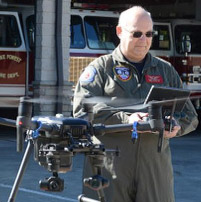You probably don’t need a COA
Inaccurate assumptions vex public safety
Many notions floating around about using unmanned aircraft in public safety are either wrong or based on bad assumptions. One of the most important (and potentially costly) misconceptions is: What kind of authorization does your agency really need?
Probably the most significant public safety misunderstanding or controversy surrounds the question of whether government public safety agencies should pursue FAA certificates of waiver or authorization (COA) to conduct public aircraft operations (PAO). Before the FAA began approving Part 107 certificates for pilots on Aug. 29, 2016, the only options available to fly drones legally were a COA or a Section 333 exemption. While Part 107 enables most public safety operations, the perception that a COA is a better way to go has prevailed.
It seems clear the FAA believed the Part 107 certification of pilots was the way forward. In 2016 the FAA said, "If you don't already have a COA, you probably won't need one when the new drone rules go into effect." With waivers and/or a quick call to the FAA UAS Hotline for emergency approval, nearly all public safety flights can be legally flown by Part 107 certificated pilots without an administrative headache and unlimited legal liability under a COA.
My experience in dealing with public safety agencies is that the continued pursuit of the COA is perpetuated by the fact others received a COA in the past. Nobody is stopping to ask if the COA is the best route forward.
When you compare the massive risk and liability COA agencies take on by flying under the COA instead of Part 107, you have to wonder if public safety agencies are making the most informed decision. Not every flight by a public agency is eligible for classification as a public aircraft operation, and a pilot without a Part 107 remote pilot certificate who conducts a public flight that is later determined to not qualify as a public aircraft flight (it can happen after the fact) would be considered to be flying without a pilot certificate or authorization. This will leave the COA agency hanging out to dry with liability and exposure to unlimited legal jeopardy. Insurance probably would not cover this flight, and the pilot in command bears the responsibility for non-compliant flight and aircraft operations. (Read more about this issue on the Public Safety Flight website.)
First things first
My recommendation is that before any public safety agency jumps into UAS operations it must first have a conversation with an experienced public safety UAS pilot who is also a manned aircraft pilot. The reason I suggest someone with a dual background in both fixed-wing or rotor-wing crewed aircraft and UAS flight is that the pilot will have a breadth of knowledge of what a UAS can accomplish and experience in dealing with the FAA and the regulations that surround aircraft operations.
This conversation should first look at what actionable information a UAS can generate for agency operations. Once that is determined, the department incident processes can be reviewed, and adjustments can be made to incorporate the UAS in the process best. The very last consideration should be to identify the specific type of aircraft that is affordable and most logical for the defined missions at hand.
Bringing UAS solutions into public safety is still new to many, and very much a process. Many departments do not have aviation experience, have never incorporated such technology, and don't yet know what they don't know. The current obstacles public safety agencies are running into are not the fault of any one person but the result of a new and confusing process in general.




